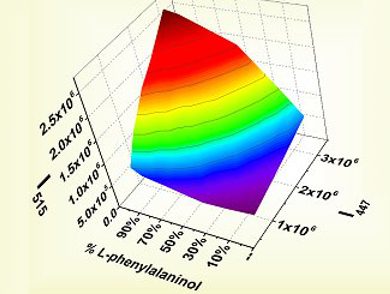Generally, two independent measurements are needed to obtain the enantiomeric composition and concentration of an unknown sample of a chiral compound because both can influence the response of an enantioselective fluorescent sensor. For application in high-throughput chiral assays, it is highly desirable for both parameters to be simultaneously determined by a single measurement.
Lin Pu, Sichuan University, Chengdu, China, and colleagues have developed a convenient method to simultaneously determine the concentration and enantiomeric composition of functional chiral amines. The team achieved this by using a combination of chiral and achiral fluorescent probes with ZnII, where the chiral probe was a 1,1′-bi-2-naphthol (BINOL)-based chiral aldehyde, and the achiral probe was the readily available salicylaldehyde.
In the presence of ZnII, the chiral aldehyde showed a highly enantioselective fluorescent response toward functional chiral amines at λ > 500 nm. The combination of salicylaldehyde and ZnII gave the same fluorescent enhancement for both amine enantiomers at λ = 447 nm, allowing the total concentration of the amino alcohol to be measured. Because salicylaldehyde exhibits a fluorescent response at a much shorter wavelength than the BINOL-based chiral aldehyde, a 3D plot could be generated of the fluorescent intensities at both wavelengths against the total concentration. This plot corrects the small effect the enantiomeric purity has on the fluorescent intensity, i.e., the total concentration measurement, at λ = 447 nm.
The method can thus be used to determine both the concentration and enantiomeric composition of functional chiral amines such as amino alcohols, diamines, and amino acids by a single fluorescent measurement.
- A Convenient Fluorescent Method to Simultaneously Determine the Enantiomeric Composition and Concentration of Functional Chiral Amines,
Zeng Huang, Shanshan Yu, Xue Zhao, Kaili Wen, Yimang Xu, Xiaoqi Yu, Yong Xu, Lin Pu,
Chem. Eur. J. 2014.
DOI: 10.1002/chem.201405143




